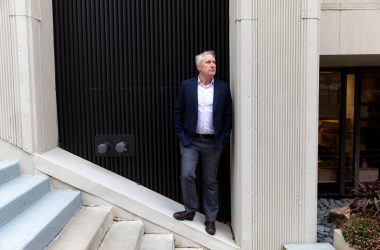A recent trial of a novel gene-editing technique that lowered dangerously high cholesterol by up to 55 percent has generated talk of a new front opening against cardiovascular disease, which kills nearly 700,000 Americans each year and is the nation’s leading cause of death.
In a presentation at the American Heart Association’s November meeting, Boston-based Verve Therapeutics announced results of a Phase 1 trial of 10 participants suffering from familial hypercholesterolemia, an inherited condition causing extremely high cholesterol, which often leads to early death due to cardiovascular disease. The treatment uses a gene-editing technique called base editing, in which precision changes are made to a single base in a patient’s DNA in the liver. In this case, the change was made to a gene that changed the liver’s handling of LDL, popularly termed “bad cholesterol.”
To learn more, the Gazette spoke with Michelle O’Donoghue, associate professor at Harvard Medical School and McGillycuddy-Logue Distinguished Chair in Cardiology at Brigham and Women’s Hospital. O’Donoghue said the advance has generated extraordinary optimism in cardiology circles, tempered by caution due to the risks inherent in changing a patient’s DNA.
Q&A
Michelle O’Donoghue
GAZETTE: This was just an initial, Phase 1 trial, but the results have generated a lot of excitement. How would you characterize the trial’s outcome?
O’DONOGHUE: This was a radical concept developed inside a lab and to see it being translated into the treatment of real people is an extraordinary leap. There’s a mix of enthusiasm and optimism for this novel technology, but also a healthy dose of caution and concern. We still need to completely understand the efficacy and safety profile of this type of approach.
GAZETTE: There were two adverse events among the participants, a heart attack and a cardiac arrest — one of which was fatal. It was ultimately determined that the treatment was likely not the cause. But do these kinds of incidents reflect why there is so much concern over safety and efficacy?
O’DONOGHUE: It’s more conceptual. There were too few patients within that initial cohort to really have a firm handle on the safety profile. As the investigators themselves stated, these were very sick persons in the first place. It makes sense to start the investigation of these therapies in patients who need it most desperately — they have genetic conditions that predispose them to very elevated cholesterol levels and already have established atherosclerotic disease (buildup of fatty plaque in the arteries). That being said, in the absence of a control group, one doesn’t know whether or not the treatment was related to the occurrence of the heart attack or fatal cardiac arrest.
But I think that the concerns are more than just theoretical. For many of these gene-editing strategies, you are, in essence, permanently changing that person’s DNA. There are different approaches, some of which are thought to be in part reversible, but nonetheless this type of strategy toward treating illness is going to come with some skepticism. And this early on, that is certainly appropriate.
“We need to follow people who are being treated with novel gene-editing therapies for several years before we can feel confident about recommending the therapies on a more widespread basis.”
GAZETTE: Is it clear that the gene involved, PCSK9, only increases LDL cholesterol? Is there any chance of unintended consequences elsewhere in the body as a result of shutting this gene off?
O’DONOGHUE: As a therapeutic target, PCSK9 is very well established at this point. It’s one of the more elegant stories of drug development. There were individuals in France who had very elevated cholesterol levels, and it was found that they had gain-of-function mutations for the PCSK9 protein. That meant that they had higher levels of this protein being synthesized by their liver cells. On the liver cell surface is an LDL receptor that is important because it mops up excess LDL cholesterol, that “bad” cholesterol in the blood.
They found that PCSK9 targets the LDL receptor on the liver cell surface for degradation. So, with too much PCSK9, that receptor starts to disappear, and you’re not able to mop up that extra LDL cholesterol in the circulation.
Scientists then found the converse. There were individuals who carried a loss-of-function mutation for that PCSK9 protein. They were found to have low rates of cardiovascular disease, and it does not appear to come at the price of other abnormalities.
We also already have treatments, monoclonal antibodies and a small interfering RNA that target PCSK9 and these have previously been shown to be efficacious and with a very acceptable safety profile.
GAZETTE: The study participants had familial hypercholesterolemia, a genetic aberration that causes very serious health problems. Might this one day be used widely, for people with mildly elevated cholesterol or will it always be reserved for the worst cases?
O’DONOGHUE: There are many factors that go into that decision. We have individuals having heart attacks at younger and younger ages, and if you ask them whether they’d rather be on cholesterol-lowering medication for the next several decades or have a one-and-done approach toward treating it, I think different people might choose different paths.
Of course, there’s going to be an appropriate degree of skepticism about gene editing until we completely understand the long-term safety of permanently editing somebody’s genes. That’s why it is relevant that some of these technologies are reversible. We need to follow people who are being treated with novel gene-editing therapies for several years before we can feel confident about recommending the therapies on a more widespread basis.
Some have asked — for cholesterol in particular — why we need a gene-editing approach when we have treatments available that are not too burdensome. But most people end up discontinuing new therapies due to concerns about side effects, cost, and just the reality of daily compliance. Even for those who are the most motivated, we know that doses get missed.
GAZETTE: You mentioned it being reversible. Is that because if you can change a base with this technology, you can easily go in and change it back?
O’DONOGHUE: It comes down to which technology is applied. The two types of gene-editing approaches that people talk the most about would be the traditional CRISPR approach, which people liken to using a pair of scissors, where an enzyme cuts both strands of DNA at a target point. That would not be expected to be reversible.
The base editing used in this case holds the possibility of being reversible. That’s why some have used the analogy that it’s more like a pencil and eraser than a pair of scissors. You’re making a single base change on a strand of DNA to change the spelling, in essence, of that gene. In theory, one could change it back if required, but that remains unproven.





